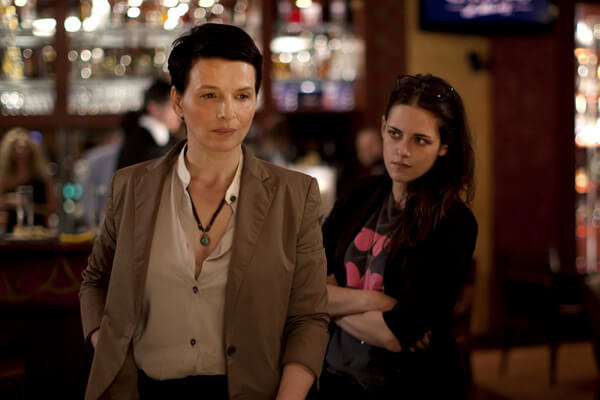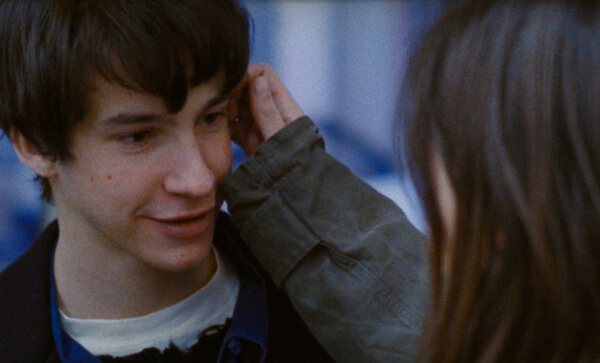Juliette Binoche and Kristen Stewart in Olivier Assayas’ “Clouds of Sils Maria.” | CAROLE BETHUEL / CG CINEMA/ SUNDANCE SELECTS
Late in French director Olivier Assayas’ “Clouds of Sils Maria,” someone compliments a young actress by saying “She’s modern.” This praise, especially directed at a woman, sounds typically Assayas.
For him, women seem to embody the energies and contradictions of present-day capitalism. He’s written memorable roles for Maggie Cheung (“Irma Vep,” “Clean”) and, to a lesser extent, Connie Nielsen and Gina Gershon (“demonlover”) and Asia Argento (“Boarding Gate”). While being married to Cheung may have allowed him access to her emotional reserves, there’s something a bit unreal about the other female characters I’ve named. They’re symbols more than flesh-and-blood women, and Nielsen’s punishment at the end of “demonlover” — seemingly for the sin of working in online pornography distribution — left a bad taste in my mouth.
With “Clouds of Sils Maria,” in which men only briefly appear, Assayas relieves his female characters from the burden of first and foremost representing modernity; he allows them to age naturally, as well. One has to remember the film comes out of a culture that’s allowed Isabelle Huppert and Catherine Deneuve careers no American actress in her 50s and 60s could easily enjoy. While hardly angst-free, “Clouds of Sils Maria” is not as doom-laden as American counterparts that tell stories about aging female performers.
Olivier Assayas has fresh things to say about what faces aging stars
Middle-aged movie star Maria Enders (Juliette Binoche) is asked to appear in London in the play in which she first became known as a young woman 20 years ago. Then she had played Sigrid, a beauty who drives her much older boss Helena to suicide. The older Maria will now play Helena.
Following the suicide of the playwright, she and her assistant Valentine (Kristen Stewart) travel to the Swiss Alps to rehearse lines. Jo-Ann Ellis (Chloe Grace Moretz), a scandal-prone Hollywood star who seems based on both Lindsay Lohan and elements of Stewart’s own life and career, prepares to play Sigrid, but her mirroring Maria’s youth brings out the aging actor’s anxieties and makes Valentine’s job much harder.
Maria and Valentine aren’t lesbians. However, the play they read to each other endlessly is a homoerotic love story. From the dialogue and plot outline we hear, it seems similar to Rainer Werner Fassbinder’s biting “The Bitter Tears of Petra von Kant.” Sexual tension emerges between Maria and Valentine, even if it seems out of place and has no real outlet in the context of their relationship.
“Clouds of Sils Maria” revisits some of the territory explored by “Irma Vep,” in which Cheung played herself as a Hong Kong movie star adrift on a low-budget silent French film remake. The most obvious connection is that Maria and Valentine go see Jo-Ann act in a cheesy 3D Hollywood sci-fi movie and then argue about its merits, evoking the argument about the respective worth of Hong Kong action movies and French cinema between Cheung and a journalist in “Irma Vep.” Maria’s problems with the movie feel both cultural and generational. Valentine contends that sci-fi genre tropes are no sillier than any other conventions and that Jo-Ann really dug into her part. Maria can’t get past mutation and superpowers as plot elements.
One might think that Assayas, as a middle-aged man making French art films, sides with Maria, but I suspect he’s more sympathetic to Valentine. As a critic for Cahiers du Cinéma magazine in the late 1970s and early ‘80s, Assayas championed North American horror directors like David Cronenberg, Joe Dante, and John Carpenter, as well as Asian genre cinema. He even defended “Titanic” in a 1997 article in the French newspaper Liberation.
“Sils Maria” refers to the Swiss town where most of the film’s action takes place. Maria and Valentine hike through the hills reading dialogue from the play to each other. Assayas captures some truly majestic vistas, but the weakest parts of “Clouds of Sils Maria” are set here. A watered-down mysticism enters the plot when Maria and Valentine get up early to watch a particularly beautiful cloud formation known as “the snake” (and shown in a silent film Maria and Valentine watch). And, the eventual fate of one of the characters mirrors that of one of the women in the play a bit too glibly.
That said, this variation on “All About Eve” is far smarter and more deft at avoiding cliché — or at least having fun with it — than most films that are made about the lives of performers.
CLOUDS OF SILS MARIA | Directed by Olivier Assayas | Sundance Selects | In English and French and German with English subtitles | Opens Apr. 10 | IFC Center, 323 Sixth Ave. at W. Third St.; ifccenter.com | Lincoln Plaza Cinema, 1886 Broadway at W. 62nd St.; lincolnplazacinema.com






































